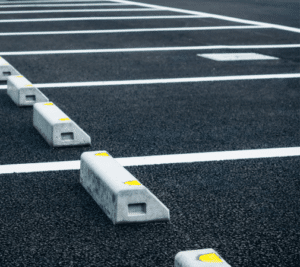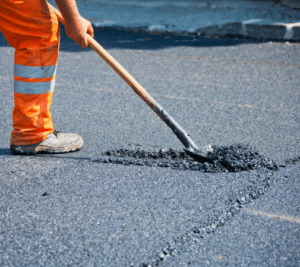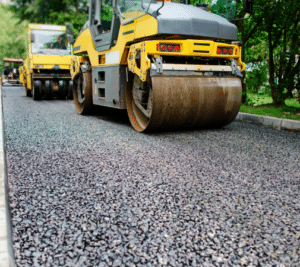Asphalt resurfacing and replacement are both important methods used to maintain asphalt surfaces. Resurfacing can be used to repair minor damages and improve the surface of the asphalt, extending its life and improving its appearance. On the other hand, replacement is necessary when an existing surface is beyond repair, and a new layer of asphalt is required. In this article, we will go over when asphalt resurfacing vs replacement is recommended.
Asphalt Resurfacing
Asphalt resurfacing is the process of applying a layer of asphalt over an existing layer of asphalt. This is done to repair and improve the surface of the asphalt, making it smoother and more durable. It can also be used to extend the life of an existing asphalt surface or to change its appearance. Resurfacing is a cost-effective way to address common problems with asphalt pavement, such as cracks, potholes, rutting, and erosion.
Reasons to Resurface Your Asphalt
Asphalt is durable and can withstand heavy traffic and weather elements over time but requires regular maintenance. One of the most popular ways to maintain asphalt surfaces is to resurface them. Resurfacing an asphalt surface entails laying down a new layer of asphalt over the existing one. This process has many advantages over having to replace an entire asphalt surface.
The primary advantage of resurfacing is that it’s much less expensive than a total replacement. It is also faster, resulting in less disruption for businesses and homeowners. Resurfacing can extend the life of an existing asphalt surface by up to 10 years, depending on the conditions of the original asphalt and how well it is maintained.
Asphalt Repair
Asphalt repair is a cost-effective way of restoring the structural integrity and aesthetic value of a paved surface. It can be used for asphalt resurfacing or replacement, though it typically requires less time and effort than complete replacement. Repairs can be made to small problem areas or larger sections, depending on the scope of the damage.
When considering asphalt repair, it’s important to determine the cause of the damage. This will enable you to choose the best solution to fix the problem and prevent it from happening again. Some common causes of asphalt damage include weather, vehicular traffic, and drainage issues.
Asphalt Replacement
Asphalt replacement is the process of replacing an existing asphalt surface with a new one. This is usually done when the existing surface is in poor condition due to age or damage and cannot be repaired through resurfacing. Asphalt replacement involves removing the old asphalt and replacing it with a new layer of asphalt.
Reasons to Replace Your Asphalt
When it comes to asphalt surfaces, the choice between resurfacing and replacement can be a difficult one. Asphalt resurfacing is a cost-effective option, as it involves applying a new layer of asphalt over an existing surface. But in some cases, replacement may be the better decision. Here are a few reasons why you may want to replace your asphalt instead of simply resurfacing:
1 . Severe Damage: If your asphalt has suffered extensive damage from water infiltration, vehicle traffic, or other sources, resurfacing may not be enough to restore the surface. In these cases, replacing the entire pavement might be more cost-effective instead of simply patching over the damages.
2. Uneven Surface: Potholes and rutting can cause an asphalt surface to become uneven over time. Resurfacing can help smooth the surface, but it may not be enough. In these cases, replacing the entire asphalt surface may be necessary to restore the pavement’s original stability and safety.
3. Design Changes: If you want to majorly change your asphalt’s design or layout, such as widening or straightening a driveway, resurfacing may not be enough. In these cases, you’ll likely need to replace the entire surface to achieve the desired results.
Cost Comparison Between Resurfacing and Replacement
Cost is an essential factor to consider regarding asphalt resurfacing vs replacement. Asphalt resurfacing is usually the more cost-effective option, as it involves applying a new layer of asphalt over an existing surface. This process can extend the life of an existing asphalt surface by up to 10 years, depending on the conditions of the original asphalt and how well it is maintained.
On the other hand, asphalt replacement involves removing the old asphalt and replacing it with a new layer of asphalt. This process is usually more expensive than resurfacing but may be necessary for severe damage or design changes. The cost of both processes will depend on factors such as size, material, and labor costs.
Regarding asphalt maintenance, both resurfacing and replacement have their advantages. Depending on the condition of your asphalt, one option may be more cost-effective than the other. Resurfacing can extend the life of an existing asphalt surface by up to 10 years while also being faster and less disruptive for businesses and homeowners. On the other hand, asphalt replacement may be necessary if there is severe damage or when making significant design changes. Ultimately, the decision will depend on your needs and budget.
Maintenance Tips for Extending the Life of Your Asphalt
Asphalt is a durable and long-lasting material, but proper maintenance is essential for ensuring that your asphalt surfaces last as long as possible. Here are some tips to help you extend the life of your asphalt:
1. Regular Inspections: Make sure to inspect your asphalt regularly for any signs of damage or wear. If you notice any cracks or potholes, fill them immediately to prevent further damage.
2. Sealcoating: Applying a sealcoat is essential in maintaining your asphalt surface and preventing water damage. Make sure to apply a new coat of sealant every few years.
3. Weed Control: Weeds can cause significant damage to asphalt surfaces over time. Use an herbicide or weed killer to keep weeds at bay.
4. Regular Cleaning: Regularly clean your asphalt surface to prevent oil and other contaminants from damaging the surface over time.
By following these simple tips, you can help extend the life of your asphalt and ensure that it looks its best for years to come.
The decision between asphalt resurfacing and replacement can be difficult, but it is important to consider the cost and design changes necessary for each option. Asphalt resurfacing is usually the more cost-effective option and can extend the life of an existing asphalt surface by up to 10 years, depending on how well it is maintained. However, asphalt replacement may be necessary for severe damage or design changes. Maintenance is also essential for extending your asphalt’s life, so inspect it regularly, apply sealcoats, control weeds, and clean the surface to ensure its longevity.
At Saguaro Asphalt, we are committed to providing quality asphalt paving and resurfacing services that will keep your surfaces looking great for years. With our expert team of technicians and advanced equipment, you can trust that your asphalt surfaces will be taken care of. Contact us today for more information on how we can help you maintain your asphalt surfaces.



